We all want our companion animals to live happy, healthy lives.
In this first episode of The Informed Animal Ally’s series on animal well-being, the Vancouver Humane Society’s Chantelle Archambault and Amy Morris discuss companion animal behaviour, emotional “tells”, and the many facets that make up a good life for domestic cats and dogs. The discussion explores a question that is dear to the hearts of many animal guardians: “Is my pet happy?”
Note: This written discussion has been edited for length.
- A good future for companion animals
- Spay and neuter
- Outdoor access for dogs
- Outdoor access for cats
- Bedding for pets
- Water access for pets
- What does pet food look like in a vegan future?
- Social relationships for pets
- The science of animal emotions
- How to tell if your pet is stressed
- How to tell if your pet is happy
- How and why pets play
- Next episode
A good future for companion animals

Chantelle: We’ve just wrapped up our series on animal cruelty, where we talked about the laws and regulations meant to protect different species from cruelty as well as the gaps in those laws.
This month, we’re flipping the script and beginning a new series where we’ll talk about animal wellbeing – what good welfare looks like for animals. The first episode will go into what a good life looks like for companion animals and answer a question that I think a lot of animal guardians care really deeply about, and that’s: “Is my pet happy?”
Amy: We know there’s more than a billion cats and dogs on earth. Our society will likely always have companion animals. Certainly cats are producing prolifically in warmer places, so I just can’t imagine a world without them, and I think dogs will do just fine as well.
One of the things that I really like to think about is, you know, if a vegan future is possible, what does a future look like for these companion animals? What does it mean to give them a good life in that existence?
I often reflect on the ways that you can keep an animal, and are the ways that we keep animals right now the best ways?
There often are compromises between their personal freedom and their physical wellbeing. So we want to keep them out of traffic – that protects their personal physical wellbeing, but it might compromise their sense of freedom and autonomy.
What does wellbeing look like for companion animals? We’ll speak about physical health and safety, and mental wellbeing is also a huge part of that. Having relationships with their guardian, if that’s what they want, or other animals, if that’s what they want, and having the ability to play and express their natural behaviours.
Chantelle: I think there’s so much to delve into with this topic, and we could speak for hours and hours about it, but today we’ll look at:
- The differences between different animals; animals are individuals just like humans are;
- The differences between different species; we’ll mostly be focusing on dogs and cats today;
- Animals who are young versus animals who are older;
- The difference between animals living in urban and rural environments;
- And how all of their needs differ depending on their situation and just their individual preferences.
Amy: And really these are opinions. “Is my pet happy?” That’s a qualitative question, measurable through different types of assessments, but I think ultimately it comes down to learning as much as you can.
So we’ll share lots here today, and my recommendation is, keep learning about anything that makes you think, “Hmm, I don’t know the reason behind that.”
Explore it. Find out more about it. Never assume that you know why your animal is doing what they’re doing, because often we’re wrong and it’s good to admit that.
Spay and neuter

Amy: Let’s start with spaying and neutering. This one is an interesting topic because in the humane movement, it has been a cornerstone for a really long time. And yet more recently, it’s become quite controversial.
I think what’s important to think about is why spay and neuter started.
Why do we spay and neuter pets?
Amy: Humane societies and SPCAs in the 1950s were so overloaded that they were doing massive, large scale euthanasia and the number of animals wasn’t really changing. There were still many animals and there were people whose jobs it was to essentially put animals to death unnecessarily. Spaying and neutering became a procedure that would be an alternative to that to stop the production of animals.
It took a really long time. That was in the 1950s when that was really prevalent. Now, 70 years later, we’re still working at this and we’re still trying to make sure that animals become spayed and neutered; because the second a community has a gap, especially when there’s a warm climate, we see numbers just bloom.
That also happens in microcosms where animals are being fed; cats in particular. All around the globe, places where animals have access to food, they’re going to have more success with breeding offspring. And then you end up with more animals living in the community than there are resources to provide for their healthcare and their wellbeing.
Benefits of spay and neuter
There’s a lot of research out about spay and neutering in general. There’s a higher quality of life associated with cats and dogs who are spayed and neutered versus those who are intact.
There’s behaviour outcomes, such as reducing mating behaviours, which can be quite conflict oriented. If you haven’t been around animals that are mating, there tends to be a lot of fights that break out, physical injuries that will happen to the males who are interested in pursuing the female that’s in heat.
And there’s also marking.
Animals will roam a lot farther. They might cross roads that they wouldn’t normally.
It also reduces the risk of some diseases like mammory cancer; vascular disease, which affects blood vessels; and degenerative diseases; any kind of cancers that would be the organs that end up being removed, they just remove the likelihood of that cancer happening.
There are some studies that show spayed and neutered dogs are at a higher risk of some other diseases, but it’s been found that the benefits far outweigh the risks.
There are some bone considerations, and so when thinking about what age to spay or neuter a large breed dog, it’s important to be in consultation with a veterinarian about that.
Spayed and neutered dogs live an average of 1.5 years longer; who knows if that’s because they’re making better decisions for themselves because they’re not motivated by their hormones or if it has to do with the diseases. But I think that stat by itself really shows us the benefit.
Chantelle: That’s really compelling. We all want the animals we share our lives with to live a long, happy, and healthy life.
Barriers to spay and neuter
Chantelle: I also want to note here that oftentimes, when an animal isn’t spayed and neutered, it’s not because their guardian doesn’t want to have the procedure done, but because there were barriers preventing them from accessing that care.
Outdoor access for dogs

Amy: Now we’ll move on to another topic that tends to be widely debated, which is outdoor access. If you’ve ever been in communities that have free roaming animals, certainly it is a different experience than that city environment where animals are kept.
I’ve been in some places as well with free roaming animals who get to make so many decisions. They’re constantly deciding who they want to interact with and who they don’t, where they want to get water from, where they want to get food from.
It’s a certain level of freedom that, you know, we ourselves are afforded.
If we think about dogs that are kept indoors, or cats that are kept indoors, what they eat, what they drink, what they drink from, who their friends are, that’s all controlled.
We might think we’re doing a very good job of all of that, and they’re pretty spoiled. And that might be the case. But certainly there’s sort of some trade-offs that happen there.
Dogs in isolation (such as dog chaining/tethering)
Amy: We know that dogs who are kept in isolation, on a leash or in a kennel, they’re kind of in the worst case because they don’t have access or ability to meet their own needs, and they don’t have the social benefits of living closely with a family.
They end up having stereotypic behaviours. Their activity levels are limited to maybe going in circles, and they’re not able to do all the natural behaviours that they want to. For instance, they love sniffing.
Dogs in the home
Amy: Dogs who live in a home get the joy and access of family life.
They hopefully get to go out, go on walks, use their nose lots, just experience the world in a meaningful way
They may or may not be going to dog parks. Something to keep in mind is a lot of people bring dogs to dog parks who don’t actually enjoy dog parks – who find them stressful, who see it as sort of like they’re facing threats rather than companionship. It’s important to read each individual dog to see how they want to experience the world.
A dog on leash might be a bit more stressed out, walking around a neighborhood with reactive dogs than a dog off-leash, but a dog off-leash that’s not well trained may end up getting themselves into fights and need veterinary care.
So it’s always balancing these different kind of wants and needs.
Considerations for leashes
Amy: Some things that I tend to think about when it’s about happiness is thinking about if you do need to contain an animal in some way – whether it be a leash or a harness and or collar to basically keep an animal safe – it’s important to think about in what ways they are confined if the dog is exhibiting a natural behaviour.
Let’s say they want to run up a mountain, in what ways are a leash and a harness or a leash and a collar confining them? Consider:
- Is it pushing on their throat, on their vocal chords?
- Are they choking or breathing strangely?
- Is it something that’s pulling on different areas, so it’s more balanced?
- Is it rubbing under their armpits?
- Are they getting friction that’s uncomfortable?
So really thinking through what the setting is and making sure that what they’re wearing is as comfortable as possible for them, knowing that they’re going to pull at the end of their leash sometimes.
Should I use an extendable leash?
Amy: Extending leashes can be confusing for dogs because they’re not sure where the end is.
They think they have more distance than they do, and then when they’re stopped short, it’s sort of shocking for them. They’re surprised or they’re focused on something else because they’ve gotten so far away.
Things like consistency can matter when you are keeping a dog on leash
Off-leash settings for dogs
Amy: When it comes to off-leash settings for dogs, we want them to have as much freedom as possible and we want to keep the safety and freedom of other dogs and animals. We also want to prevent them from eating things that are toxic to them.
It’s important to be mindful about where you choose to walk a dog off leash, how well trained they are, and also mindful of which other dogs might be around or wild animals. Thinking all of those things through to make sure that your dog gets the happiest experience they can.
Outdoor access for cats

Chantelle: When it comes to indoor-only or indoor-outdoor access for cats, there are safety considerations and other welfare considerations.
Risk of illness and injury for outdoor cats
Chantelle: Cats who free roam outdoors are at greater risk of injury and illness.
One study found that cat guardians in urban settings are more likely to keep cats indoors only, whereas guardians in suburban or rural settings were more likely to have indoor outdoor cats. Many guardians in urban settings cited car accidents as one of the reasons that they keep their cats indoor only. But another study actually found that outdoor cats were just as likely to be victims of road accidents in rural and urban areas, and it doesn’t really make that much of a difference.
- They could be hit by a car.
- There could be attacks from predators.
- There could be bites from other cats who might have transmissible diseases, and then that could lead to a longer term health issue.
- They could be poisoned from eating toxic plants or poisoned rodents or other substances.
- They could contract parasites like fleas, ticks, and worms.
Enrichment for indoor cats
Chantelle: Indoor-only cats can get bored, so they might need additional enrichment to make sure that they’re getting enough physical activity and they can express their natural behaviours like chasing and pouncing.
Individual cat preferences
Chantelle: Individual cats will also have different wants and needs depending on how old they are and what they’re used to.
So for instance, like a newly-adopted kitten in an apartment building might be perfectly content having playtime with their guardian; but an adult cat who’s used to being like an outdoor barn cat in the country would be more likely to want to do what they’ve always done.
Safer outdoor options for cats
Chantelle: There are also safer options for cats who like to be outside.
If you want to make sure that they’re safe while doing so: there’s enclosed patios, you can take them on a walk with a harness close to home if that’s something they’ll tolerate.
I share my home with a cat, Callie. She’s an indoor cat and she’s really skittish around loud noises, but she still likes to have some outdoor time supervised in a fenced yard, and she likes the option to go back inside anytime she wants.
Cats and wildlife
Chantelle: With cats, it’s also important to consider the wellbeing of wildlife.
Cats are predators, so they have natural hunting instincts and that makes them a risk to birds and other small animals. They’re not a native part of Canada’s ecosystem, so they’re considered an invasive species, and that can be a concern as well.
Bedding for pets
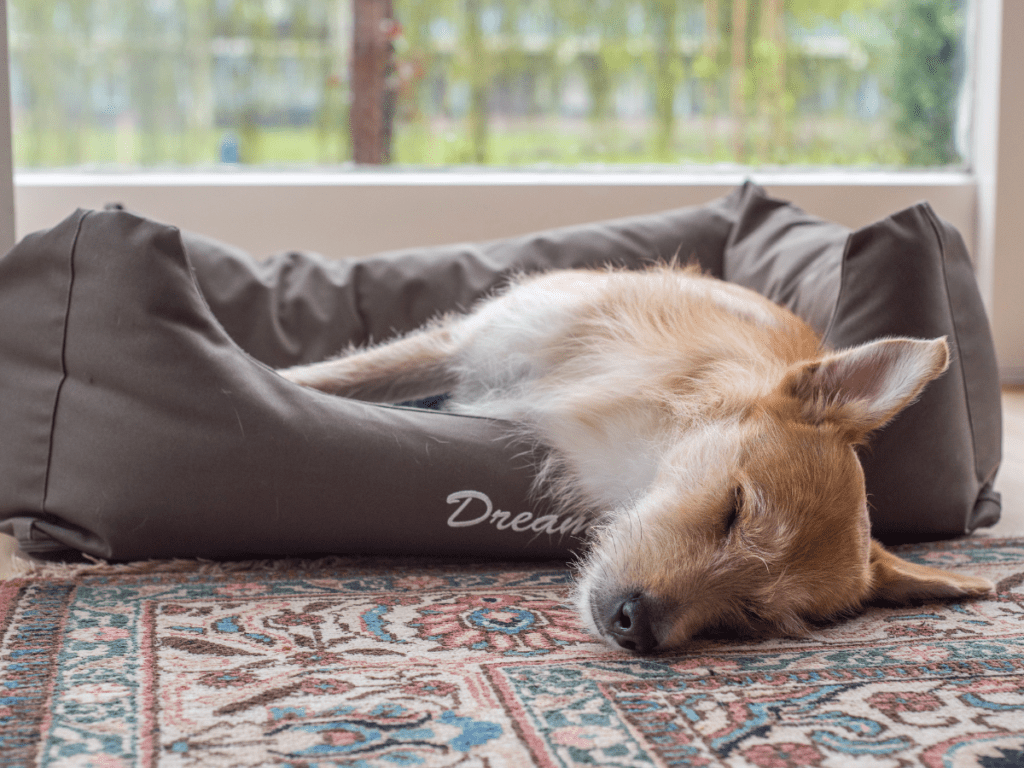
Amy: Something we can talk about pretty quickly is bedding for animals.
I think this is pretty much common sense. Most people know that animals will sleep wherever they want to sleep
That’s going to really differ based on the age of the animals. Older animals tend to pick softer surfaces.
Bedding for dogs
Having a variety of surfaces available is really important. Options include:
- Commercial dog beds;
- Blankets and towels – dogs like to nest;
- High pile rugs;
- Cold surfaces like tile;
- Straw.
In a cold environment, anything that’s insulating, such as a hut with appropriate siding and straw and things like that.
The most important thing of all bedding is always making sure it’s dry; checking it on a daily basis. Just like us as humans, they can get cold and they can be impacted by wet bedding.
Bedding for cats
Chantelle: I think that covers it really well. Going on my theme of just adding on with cats, the best cat bed is really suited to each individual cat and the way they like to sleep. You can observe that when they’re lying down.
If they like to stretch out, a larger, flat bed might be good. If they like to curl up in small spaces, a bed or a basket that’s enclosed on the sides might be better for them. It’s great to have a variety so that they can choose where to be.
Some cats also like blankets or towels folded up on a surface.
Some cats like commercial cat beds or baskets, but pretty notoriously, a lot of cats will prefer the box that the bed came in over the actual bed.
Some studies show that cats in unfamiliar situations, like being in a shelter, feel less stressed when they have access to a cardboard box. Many cats will translate that to places that they’re comfortable in, like their home.
Amy: I think we do this as well when we’re in an unfamiliar environment, we look to all of our resources to go, “What’s available to me? Where can I be safe? Where can I be alone?” If you’re at a dinner party and you suddenly need a break, you’re gonna go into the kitchen or maybe into another room where it’s quiet.
All of these things seem like common sense, but it’s a reminder to relate animals to ourselves because we have the same psychological motivations.
Water access for pets
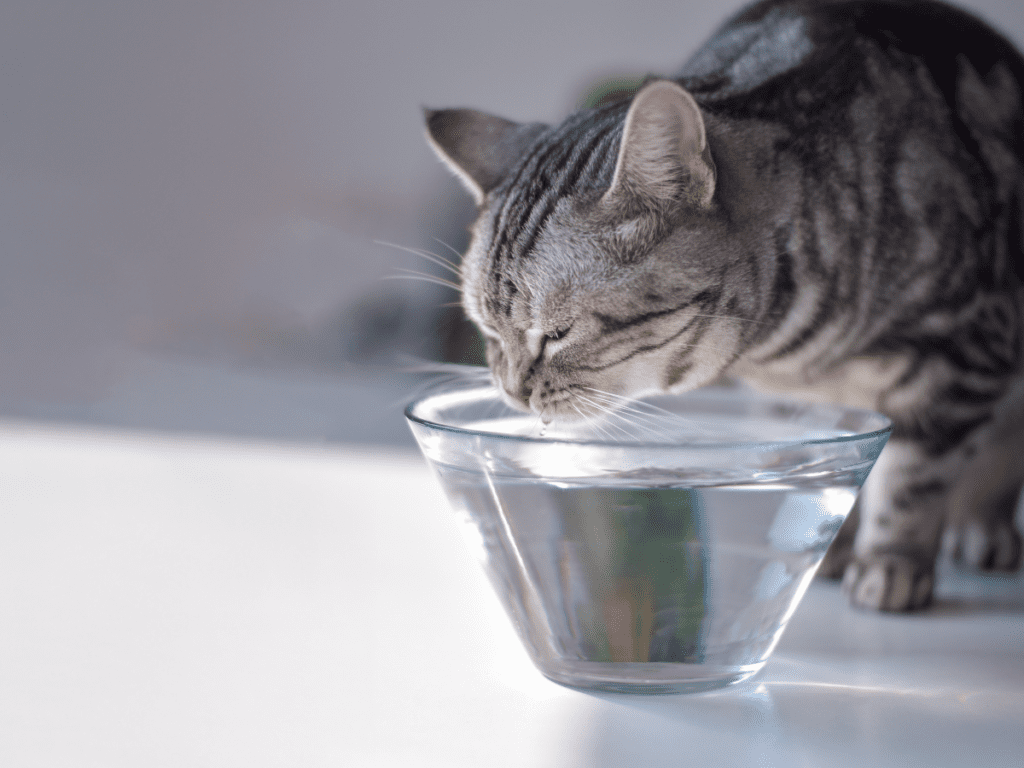
Amy: The same principle applies when it comes to water. We like access to fresh, clean water. If water sits around for 24 hours, I might dump it out for myself and get myself a fresh glass. The same goes for animals.
They often don’t like the saliva of another animal, so if you have multiple animals living in a house, keeping multiple water dishes and changing all of them on a regular basis is important.
Cleaning the bowl is really important because they can build up saliva and then bacteria over time.
When you have animals living outdoors, it’s really important for the water to not be frozen and to make sure it’s kept fresh and clean as well.
Chantelle: For cats specifically, most cats prefer to have at least one water bowl that’s not next to their food dish. Cats have an instinctual fear of contamination from their food going into their water source.
Amy: The best thing is to just have as many water sources as possible around the home.
What does pet food look like in a vegan future?
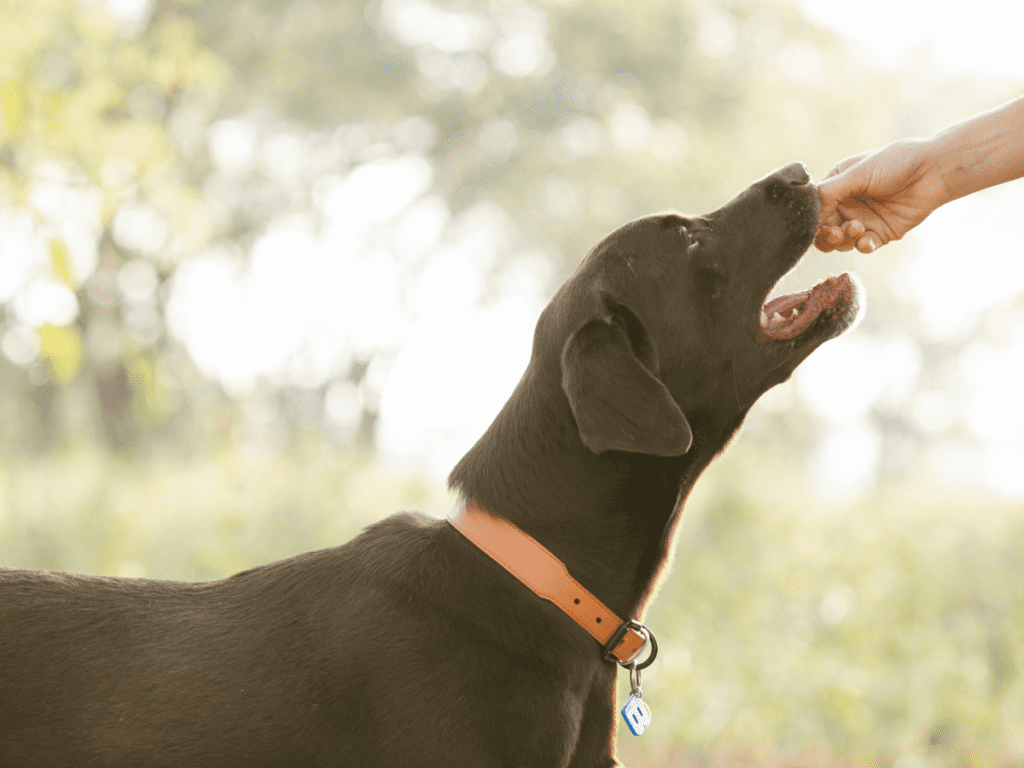
Amy: Food is a really complicated one, especially as Vancouver Humane Society is a vegan organization. We advocate for an end to all animal suffering, including for farmed animals.
That can be really complicated when it comes to feeding companion animals like cats and dogs who typically eat some meat in their diet; but it doesn’t have to be.
The ideal we’re working towards is a future where animals are not used and killed for food, and where human-animal relationships are respected, and all animals have an opportunity to thrive. There are developments that are making this possible
Chantelle: Absolutely. And looking into the future, I think the simplest solution is to use lab-grown or cultured meat for companion animal food. There’s one company that I know of that’s already doing this with cultured meat pet treats; that’s a really interesting development.
And then we need to look at, if that’s the ideal, how do we get there? So we can advocate for innovation to develop those cultured meat alternatives and make it more accessible in terms of availability and cost. We can also continue to conduct and follow the research around what nutrients animals need.
Each animal guardian will need to observe their companion animal’s health and behaviour, and then make the best choices that enable your companion animal to thrive.
That could mean introducing plant-based foods. There’s new research being done into the healthfulness of plant-based diets for pets. A lunchtime live from Animal Justice Academy goes into depth on this topic.
Learn more about the research on plant-based diets for companion animals:
There are a lot of options and there’s a lot of development into a better, brighter future for all animals.
Social relationships for pets
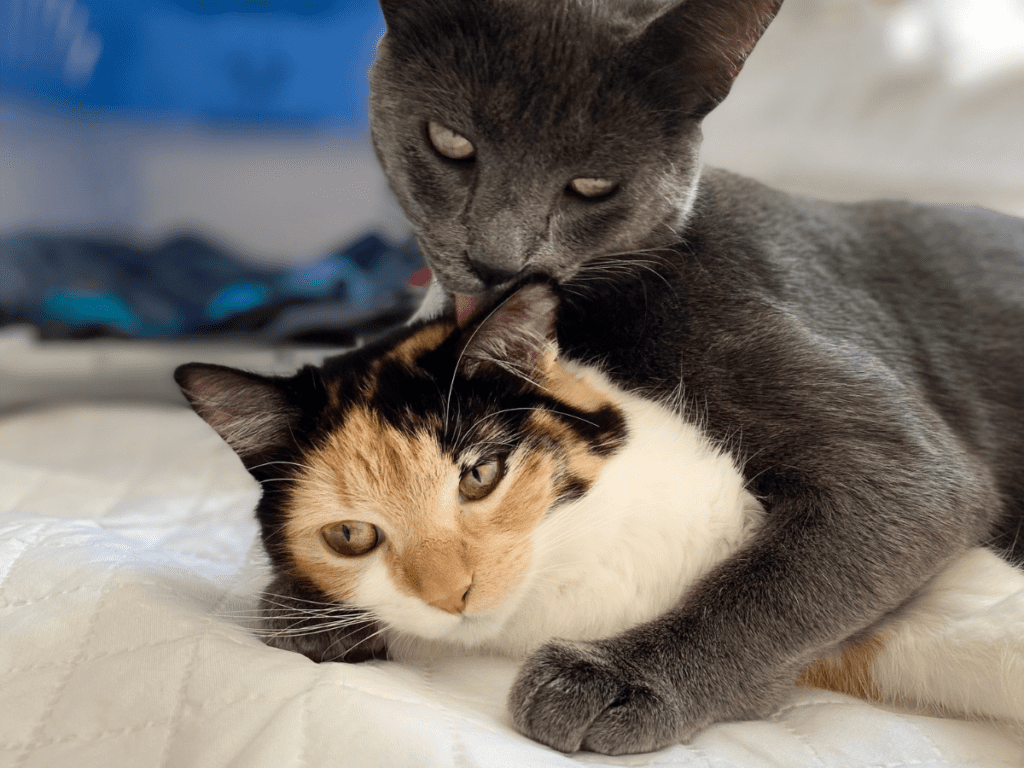
Chantelle: The next thing we could touch on is relatationships. Companion animals are social. Much of the time, they thrive when they have a strong relationship with their guardian.
Human-animal bonds
As we mentioned, more than half of Canadians share their home with animals and most consider those animals to be part of the family. I know I certainly do.
That relationship can look different for different individuals. Some dogs always want to be right beside their person. Some enjoy more alone time. In some cases, animals who were previously feral prefer lots of space, and they can take years to warm up to their caregivers.
In general, it’s a good idea to build trust, to let your companion have their own agency on when to engage, and to listen to their communication.
Bonds between animals
Chantelle: There’s also some animals who have strong relationships with other companion animals in the house, if there are any.
Again, that depends on the individual. Some prefer to be a one-animal household and some are bonded with each other.
You’ll see this in feral dogs and cats too. Feral dogs typically have their own routines, but they’ll buddy up with each other and spend time together. Some feral cats live on their own; some like to form colonies. It’s an individual preference.
Should I adopt a second pet?
Chantelle: When you’re making a decision about whether to open your home to one or more companion animals, you can look at their current and previous relationships to give you an idea of how they respond to relationships with other
Amy: This one is really interesting and complicated because certainly we get in our heads sometimes, thinking, “There’s a lot of dogs out there that need to be rescued, and I have one, but maybe I have space for another.” And so we go, “Okay, I should get another dog because I have the space and capacity to do so.”
And meanwhile, the dog that you have isn’t really keen to share their space. And the same can go for cats.
It’s important to get a read on, is your dog or your cat or your rabbit happy in and of themselves? Do they seem like they’re longing for more social connection?
I had one dog who would just cry whenever I left the house, and I had some foster puppies and I videoed to see what would happen when I was away. I had basically a kennel with an ex pen around it, and he jumped up onto the table to jump onto the kennel, to go into the ex pen to lay down with the puppies. And he was so much calmer when he was doing that. And I realized, okay, he needs to live with other animals. He’s just too sad to live alone, or to be left alone.
My companion dog now does not want another dog in the household. She’s very protective and she wants all the treats and toys and water to be hers and hers alone.
Looking at, at the individual is important.
The science of animal emotions
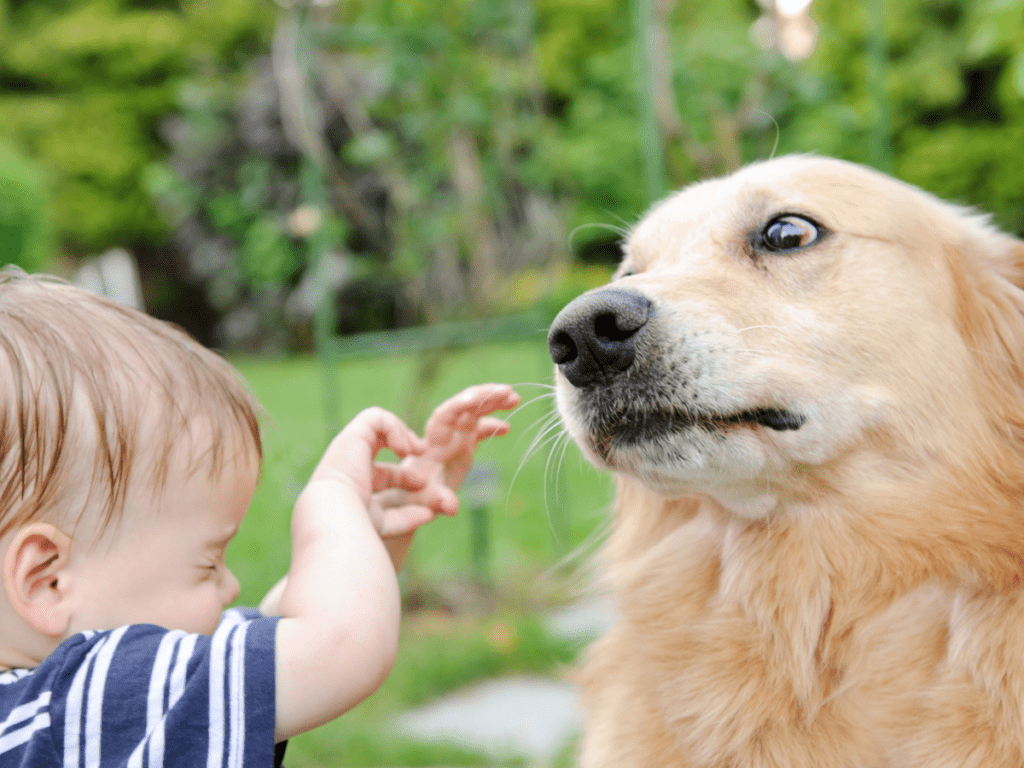
Amy: Let’s go into a little bit of biology on animal behaviour.
We know so much now about animal behaviour grounded in science, which is incredible. If the language gets too technical, we’ll get to a point that maybe we’ll feel a bit more relatable.
Mammals – like humans, dogs, cats, rabbits – have an autonomic nervous system. This system manages involuntary physiological processes, including heart rate, blood pressure, respiration, digestion, and sexual arousal.
It contains three distinct divisions. There’s the sympathetic autonomic nervous system, the parasympathetic autonomic nervous system, and the enteric autonomic nervous system.
Sympathetic nervous system (fight, flight, freeze, or fawn)
So you may have heard of the fight or flight response; that’s really well known. It’s actually a really simplified explanation of one function of our sympathetic nervous system (SNS). The SNS engages with nearly every living tissue in our body.
When we and our pets experience stress, it’s our SNS that responds. It may respond with one of four reactions, the well-known fight and flight, as well as the lesser known freeze and fawn.
With animals, you may notice fight presenting as biting, growling, barking, or bearing teeth, with dogs; or swatting, hissing, or an excited but tight tail wag for cats.
You might notice flight when they run away or cower behind you.
Freeze can be much more subtle. Sometimes in dogs you’ll see the whites of their eyes, a stiff position, a stiff tail or them kind of laying down and staying put. This response is really common in rabbits and chickens as well. Often people think that they’re calm when actually they’re just as stressed as an animal who is fighting or fleeing, they’re just frozen.
Fawn also presents itself, for example, in dogs when they show their bellies, wag their tails, trying to make them seem as unthreatening as possible.
Parasympathetic nervous system (rest and digest)
The parasympathetic nervous system (PNS) is responsible for calming. It’s known as the rest and digest system, specifically involving the vagus nerve. This nerve also has a role in providing an early warning system for us and animals for things like colds and flus. It also monitors the body’s recovery.
To get an idea of whether a pet is happy, it’s good to understand the signs of their sympathetic nervous system being activated, as well as their parasympathetic nervous system responding.
How to tell if your pet is stressed
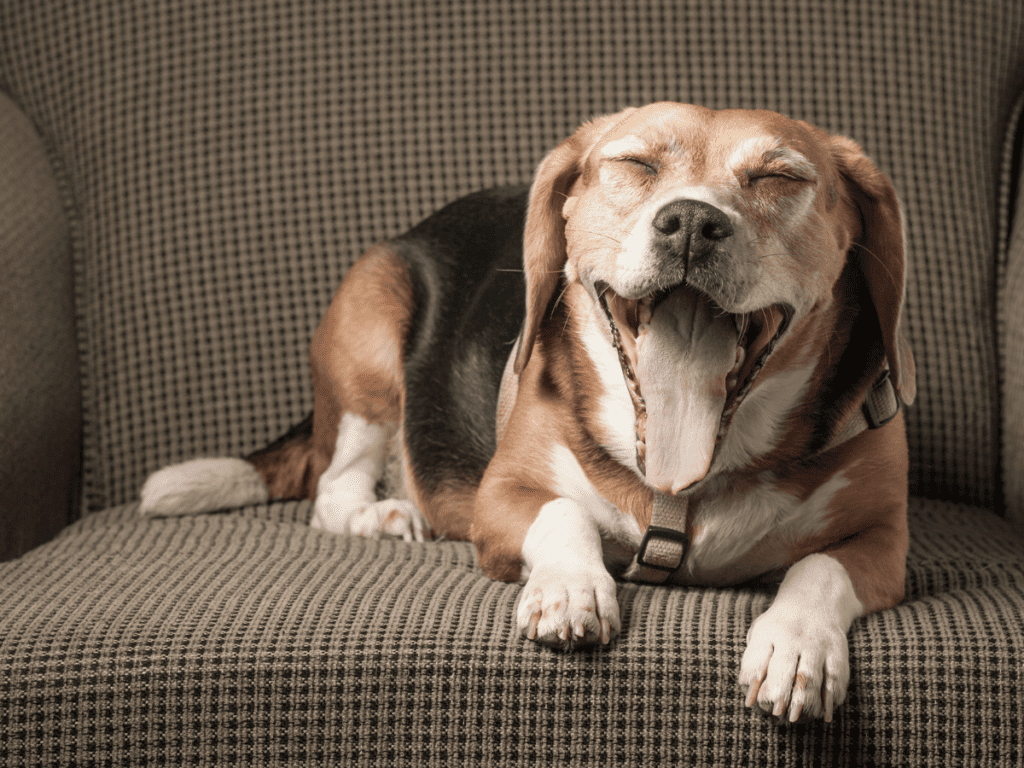
Amy: When it comes to things like calming, we know that dogs can calm themselves by shaking. There’s an entire body of therapy for humans dedicated to that called somatic movement; they might call it displacement behaviours as well.
For animals, you can see them trying to manage stress by panting, yawning, licking their lips, whining.
Whining can also be considered a fawning response because the dog might be seeking connection and reassurance.
I mentioned “rest and digest”, so animals might also also go to the bathroom after a stressful situation. Peeing can be a fear response.
I often see this in spay neuter clinics when animals wake up from a surgery; it’s the most stressful thing that they experience probably in their lifetime. They will pee and poo as the first thing they do when they wake up.
Cats are notorious for their freeze response, and in lots of cartoons, you see that puffing up and then not moving. They’re also excellent at hiding if they have enough time to assess the situation and know that they have a safe getaway.
Cats might also develop maladaptive eating and toileting behaviours if they’re chronically stressed.
And of course, going back to the that fight mode, I think we’ve all seen cats that know how to engage in the fight mode and conflict as well.
Sometimes signs of stress are subtle. In cats, they can exist over a long period of time. So in a household with more than one pet, it’s really important to have different water sources and litter boxes to prevent one animal from being able to guard all of the resources.
How to tell if your pet is happy
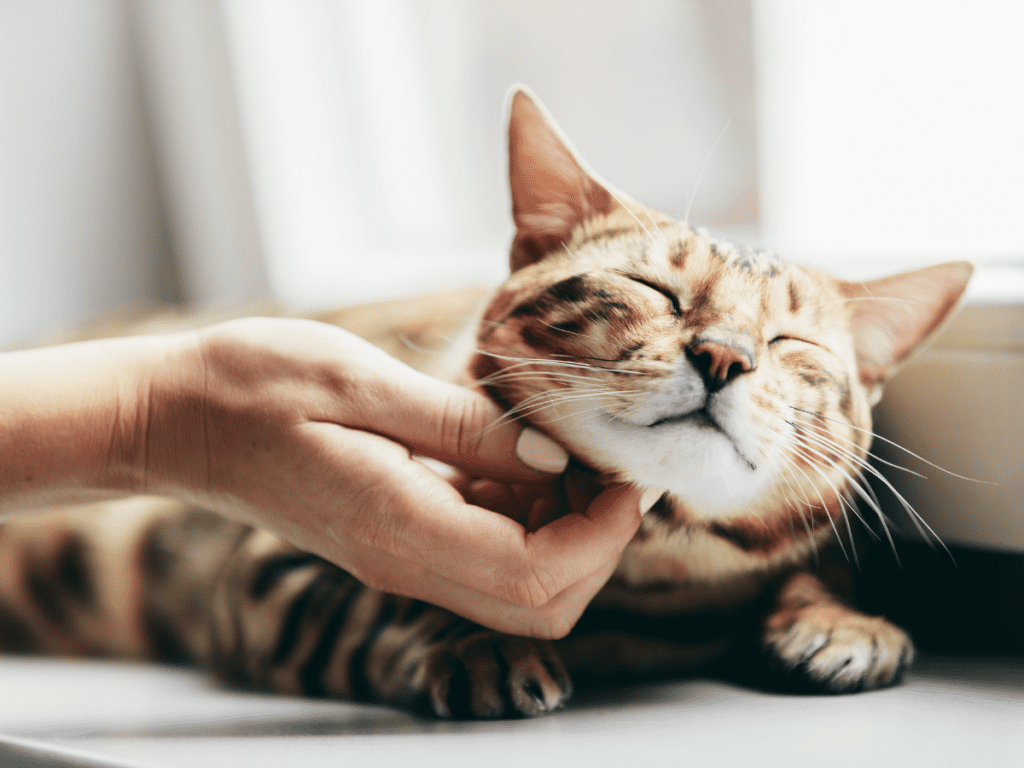
Amy: So now that we know what stress looks like, what other states are there that animals experience?
How to tell if your pet is excited
They can be excited, which can look like stress, but typically they’ll have irregular ear and tail movements that show like anticipation; so they’re frozen or in an aggressive state.
How to tell if your pet is content
Amy: Happiness can mean excited; or it can mean calm, it can mean content. That is going to differ outside of the excited state. You’ll see an animal’s body be very loose, eyes being soft, they might blink more slowly.
Chantelle: A lot of cat guardians are familiar with cat slow blinking as a sign of affection.
Amy: Cats might even knead with their paws or rhythmically swish their tails or rub against you. Dogs might lay on their backs or sprawled out and wag their tails.
How to tell if your pet is playful
Amy: They show signs of playfulness, including seeking out toys. Dogs even have a certain kind of laughter that typically comes out when they’re playing with other dogs, but if they have a good bond with you, it might be possible to hear it from them when you play with them too.
And they’ll be comfortable grooming themselves and eating and cats they might purr or chirp.
The difference between cat and dog behaviour
Chantelle: I find that a lot of the time, when someone is really familiar with only dogs, they can find cats’ behaviour sort of confusing and vice versa. And I think that’s probably because a lot of behaviours that you mentioned have opposite meanings depending on the species.
So for instance, when a dog yawns, they could be feeling fear or stressed, but cats tend to yawn when they’re relaxed.
Both of them wag their tails for a lot of reasons, but more commonly it’s associated with dogs being happy or excited, and cats being kind of annoyed. I just find it really interesting to look at the differences between their behaviours.
How and why pets play
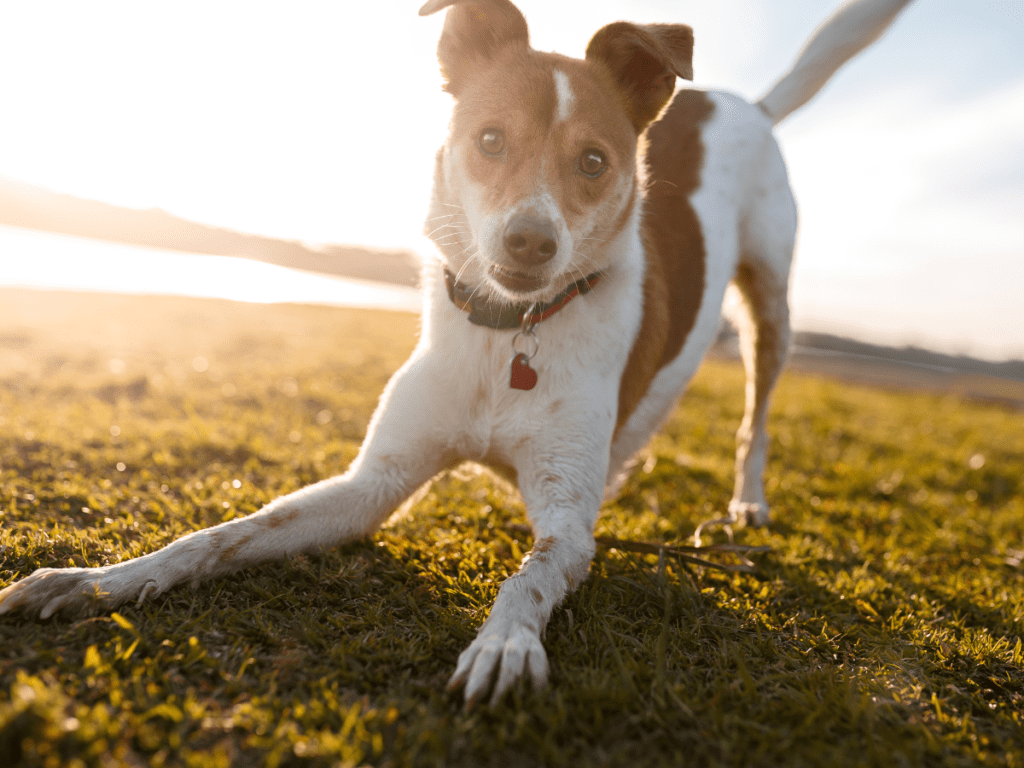
Amy: I’d like to chat a little bit more about play. I mentioned it briefly. I absolutely love watching animals play.
As you’ve noticed, we have mostly been talking about dogs and cats. For any species outside of dogs and cats, I really recommend researching their natural behaviours around fear, stress, and play. Sometimes people think an animal is doing well when they’re actually stressed or afraid.
One really important aspect of play is considering the play from the perspective of the animal.
How dogs play
One example would be playing tug of war with the dog. I know there’s a misconception out there that this game can be used to establish a hierarchy where there’s one winner – always the guardian – and they’re the one in charge. This isn’t play.
Power can be a factor in play, but dogs prefer to set the rules and, and if they’re not setting the rules, they don’t really see it as play. They’re just doing what they have to, to get the response from you that they need.
Typically, if they’re playing, they’re the ones in charge. If you give a dog space to do so and you give them resources and you give them your time and engagement, they’ll start to create games and teach you how to play with them the way that they want; whether it’s hide and go seek, fetch, tug of war, scent games, learning tricks, or agility.
It’s really important that a dog is positively reinforced and always given options so that they can communicate whether they want to opt into the activity.
If you choose to engage in physical play with a dog, really take it slow and observe what they respond well to.
With my dog Clover, I can tell when I get a play behaviour right because when I move backwards, she’ll actually come towards me. So she’ll say, “Hey, this is fun. I want to keep doing this.” That’s an example of giving choice.
Something that comes up frequently with play and dogs is mouthing.
It’s really important to recognize that bite inhibition is best taught to puppies because they’ll learn it easily that way. If a dog wasn’t taught bite inhibition as a puppy, it’s really important to follow a very specific training protocol using positive reinforcement to prevent accidental injury during play and to make sure everyone is happy about the outcome.
How cats play
Chantelle: I love talking about animal play as well.
Most cats like to play both by themselves and with another cat or person; in other words, solitary and social play. Generally, the way they play reflects their natural hunting behaviour, like stalking, chasing, pouncing.
Solitary play usually involves a cat interacting with their environment or toys, like batting around a toy mouse or jumping in paper to bags. Animals are just as unique as humans are, so different cats will have different toy preferences.
You can also play with your cat with their toys as a form of social play, like moving around a wand toy for them to chase, or throwing a small toy.
Every cat has a different style of play when they’re playing socially. Some cats love to chase toys that are thrown and some will even bring them back. Some like jumping up at a wand toy when you dangle it above their head, like they would if they were doing their natural behaviours chasing a bird; some like to kind of pounce on it on the ground like they would with a mouse. Even how you move the toy can make a big difference in whether they’re interested or not.
One way that cats play with each other is by fighting or chasing, and some cats also like to do this with people. It’s important to really read your individual animal companion’s behaviours.
It’s also important to teach your cat not to bite you. It’s easiest to do this when they’re young by putting a large object like a stuffed animal between you and the cat when they start to bite.
That being said, some cats can have a lot of fun with games like hide and seek and tag. Cats will also let you know which toys and games are their favourite, because they’ll play with those more and they’ll either initiate the play themselves or they’ll be receptive when you start playing.
Going back to behaviour, a playful cat will typically have dilated eyes and will focus on the thing that they’re playing with. Their tail might also be up, which is typically a sign of friendliness or their tail could be twitching to show they’re excited. If they’re growling or hissing or flattening their ears, that’s a sign that they’re really no longer feeling playful and have actually become frustrated.
Also to note, cat toys don’t have to be expensive. Most cats actually love playing with found items that are around the home. As long as it’s a safe item, not a choking hazard, it can be something that they consider a toy.
(A choking hazard includes items that have parts or materials that can break off, and either a part of the object or the whole object can fit entirely into the cat’s mouth and be swallowed.)
Some favourites in our house are the rope strings that come out of hoodies, hair scrunchies, boxes with a hole cut out, rugs, rolled up socks, paper bags. The world is open for cat toys.
Why do cats get zoomies?
Chantelle: Sometimes, cats also get zoomies where they run around, maybe pounce on things or run in and out of hiding places. Sometimes they meow really loudly. This can be alarming, but is typically a normal cat behaviour.
Cat zoomies are called frenetic random activity periods (FRAPs).
FRAPs are usually a normal way for cats to burn excess energy or express excitement. If you get woken up at 3:00 am, you might be familiar with this.
If a cat is doing this a lot, it could mean that they need more enrichment throughout the day to get the exercise they need and engage their mind.
If their running behaviour is unusual or seems distressing to them, you can check in with your veterinarian to find out if it could be due to an underlying health issue.
Next episode
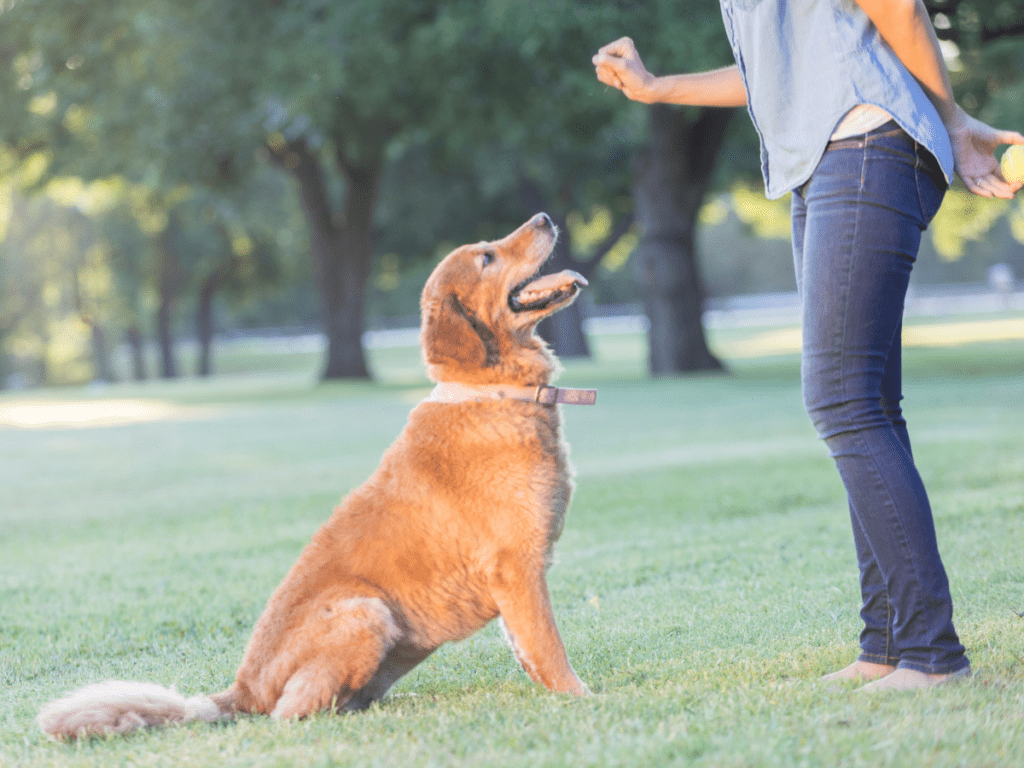
Please join us next month as we delve into the topic animal training!
